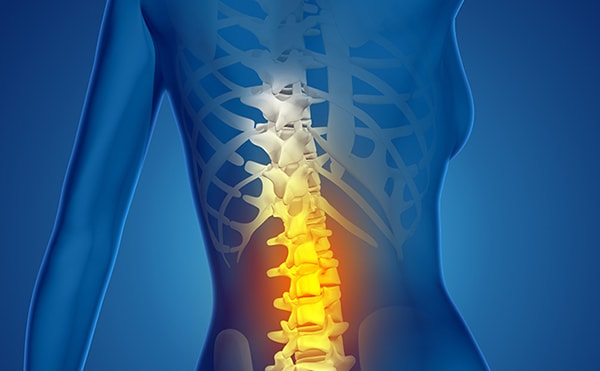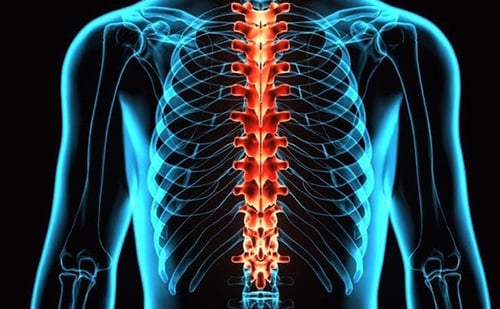T9 - T12 Spinal Cord Injuries
The lower sections of the thoracic spine are known as transition vertebrae because of their proximity and similarity to the lumbar vertebrae.

The lower sections of the thoracic spine are known as transition vertebrae because of their proximity and similarity to the lumbar vertebrae.
The T9, T10, T11, and T12 vertebrae form the base of the thoracic spine. The thoracic spine is made up of 12 segments total between the cervical and lumbar levels. Sections T9 - T12 are known as transitional vertebrae because of their proximity and similarity to the lumbar vertebrae. The spinal cord and nerves’ correlation to these levels, along with the rest of the thoracic spine, aid in controlling the trunk of the body.
The completeness of the spinal cord damage will determine how severe an injury truly is and the level of recovery that can be expected by the patient. Thoracic spinal cord injuries may be classified as complete or incomplete, and may affect one or both sides of the body. The thoracic spine is much more stable than the cervical spine because of its proximity to the rib cage, and injuries to this area are not as common.

The ninth thoracic vertebra is also known as T9. It is a segment of the thoracic level of the spinal column and is the first of the four transition vertebrae. The T9 vertebra directly communicates to the adrenal glands through nerves.
Also called the tenth thoracic vertebra, T10 is one of the twelve vertebrae of the thoracic spinal column. The nerves that control the muscles of the lower abdomen originate through here.
The eleventh thoracic vertebra (T11) is one of the last thoracic spinal vertebrae. It’s the first of the transitional vertebra that is not attached to a true rib, meaning a rib bone that connects to the chest’s sternum.
The T12 vertebra is the last member of the thoracic spinal column before transitioning into the lumbar section of the spinal column. The twelfth thoracic vertebra is the largest of the thoracic vertebrae.
The first of the transition vertebrae, the T9 vertebrae location is between the T8 and T10 vertebrae.
The T10 vertebrae location can be found between the T9 and T11 vertebrae within the torso.
The T11 vertebrae location is near the bottom of the thoracic spine, at the first “false” ribs. It rests between the T10 and T12 vertebrae.

The T12 vertebra sits right above the lumbar spinal column. It is the largest and most inferior of the thoracic spinal vertebrae. The T12 vertebrae location is between the T11 vertebra and the first lumbar vertebra, L1, in the trunk region.
The most common causes of thoracic spinal cord injuries to the T9 - T12 levels are:
Since the T9 vertebra directly communicates with the adrenal glands, damage to this vertebra may produce severe symptoms in the kidney area. Any damage to the thoracic vertebrae causes moderate to severe back pain that is exacerbated by movement.
An injury to the T10 vertebra will likely result in a limited or complete loss of use of the lower abdomen muscles, as well as the buttocks, legs, and feet. A minor injury will result in minor symptoms such as weakness, numbness, as well as partial or complete lack of muscle control over only one side of the body. Severe damage to this vertebra can result in complete paraplegia.
A T11 injury will demonstrate itself by severe back and leg pain. If the nerves in the T11 vertebrae are damaged, common symptoms include weakness and numbness in these areas.
Like the other transition vertebrae, T12 vertebra pain symptoms involve severe to moderate back pain depending on the seriousness of the injury. Limited function of the legs can result as well, though this may be limited to only one side of the body.
Patients with an injury at the T9 - T12 vertebrae levels may also experience:
Although T9 - T12 are very similar, there are thoracic vertebrae differences. Each descending vertebrae is larger than the one before in order to support the weight of the above spinal column. Therefore, the T12 segment is larger than the previous T9 - T11 vertebrae.
Additionally, each vertebrae protects spinal nerves that correspond to different areas. For instance, T9 contains nerves that connect to the kidney area while T12 has nerves that affect the buttocks and lower abdomen muscles.
Although the thoracic vertebrae are connected to ribs, only T9 and T10 have “true” ribs, or ribs that are fused into the chest’s sternum.
The T9 - T12 are part of the twelve vertebrae that make up the thoracic section of the spinal column, which lies between the cervical and lumbar regions. Other thoracic vertebrae names that these four vertebrae are known by include “transition vertebrae” since they descend into the lumbar spinal column.

Although thoracic spinal cord injuries are severe, they are not as fatal as SCI higher up on the spinal cord. Thoracic spinal cord injuries may affect one or both sides of the body, and although the long-term prognosis is good, early treatment is still critical for the outcome. Here are some different spinal cord injury types that account for most thoracic vertebrae injuries.
Thoracic vertebrae fractures are usually due to accidents with hard falls and physical trauma, or conditions such as osteoporosis. This injury occurs when the vertebrae spine collapses in its weakened state due to pressure. Thoracic vertebrae fractures are also known as compression fractures since pressure causes the weakened thoracic vertebrae to collapse.
When there is too much pressure on the vertebra, the bone collapses. The front (anterior) part of the vertebral body forms a wedge shape while the porous, cancellous bone on the inside of the vertebral body is crushed, or compressed. In severe cases, the compression fractures will cause the back of the vertebral body, the thick oval segment of bone forming the front of the vertebra, to actually protrude into the spinal canal and put pressure on the spinal cord. However, this is rare.
Thoracic vertebrae breaks can shatter one vertebra into multiple pieces, which is known as a burst fracture. Severe trauma, such as a motor vehicle accident, can account for shattering vertebrae. Thoracic vertebrae breaks need immediate attention since the bone fragments can become displaced and harm the spinal cord.
When a vertebra is moved out of place, it is known either as a thoracic vertebrae misalignment or a thoracic spine subluxation. The spinal column’s normal curvature becomes disrupted and a vertebra is misaligned. This can cause nerve irritation and a disruption in the nerve-brain message channels if the spinal cord is affected.
Depending on where the injury is on the thoracic spinal column, patients can live very independent lives with their injuries. The most limiting factor of a thoracic spinal cord injury is the inability to control bladder and bowel function, but the patient is able to adapt to this quickly.
If the injury is below T1, then the patient will have the use of their arms, chest, and upper back. If there is a severe injury to the T9 - T12 vertebrae, like a fracture due to a car accident or violent trauma, then the patient may be left a paraplegic. However, people with thoracic injuries can still:
As is the case with the majority of spinal cord injuries, SCI vertebrae treatment for injuries at the lower thoracic level are aimed at keeping function to the non-affected areas and to encourage function at the affected area.
Current treatments for spinal cord patients with thoracic injuries are:
Physical therapy is essential for rehabilitation. Patients with thoracic injuries between the T6 - T12 vertebrae can develop good ability to control their torso while sitting with physical therapy. Gait training with walking devices can also help retain the remaining function in the patient’s lower body.
Patients will also participate in occupational therapy to learn to use their hands; this may be difficult in the beginning, as well as learn to dress and bathe independently.
Additionally, mental health is key for thoracic SCI recovery. Psychiatrists are helpful for spinal cord injury patients since they help to keep the patient in the best mind frame for recovery.
Spinal cord injuries in the T9 - T12 vertebrae often result from severe trauma or compression fractures (bone damage that leads to a shrinkage of the vertebrae). T11 and T12 vertebrae are particularly flexible sections of the spine and are subsequently the most common areas of the thoracic spine to get damaged.
Thoracic spinal cord injuries are less severe than cervical spine injuries. With proper SCI vertebrae treatment, patients with thoracic spinal injuries may even go on to live normal lives. Many survivors use manual wheelchairs and are usually able to live alone. They are able to care for themselves and move in and out of their wheelchair alone. The lower in the spinal cord that the damage occurs; the more function can be expected. Some thoracic spinal cord damage patients even drive modified cars.
Spinal cord injuries are traumatic for patients and their families. They cause disruptive changes to every aspect of your life and there is a lot of new information to navigate and understand. Our experts have collected everything in one place to help you learn more about your injury, locate doctors and treatment centers, find financial support, and get assistance navigating your next move.
Sponsored by Tampa personal injury lawyers at Swope, Rodante P.A. a Florida law firm located at 1234 E 5th Ave, Tampa, FL 33605.
The information provided by SpinalCord.com is not a substitute for professional medical advice, diagnosis, or treatment, see Disclaimer Policy.